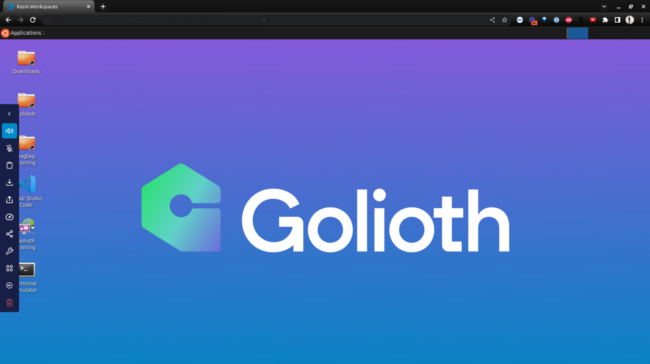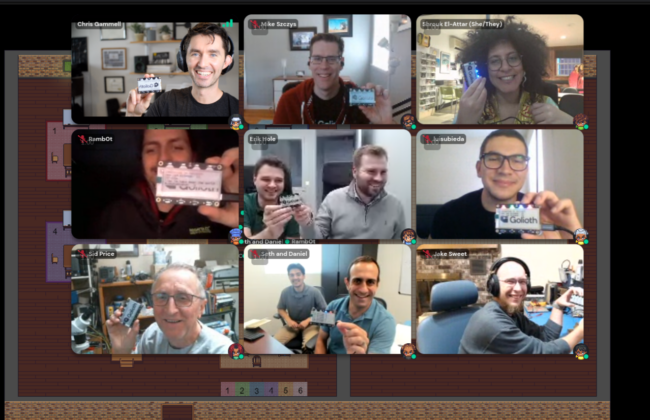Understanding hardware and firmware is the first step towards building any kind of “thing” that will be part of an “Internet of Things” (IoT) deployment. For new chips and firmware ecosystems, this often means going through training.
Golioth Developer Relations (the group I’m part of) is tasked with making sure our users understand how to get their hardware connected to the Golioth Cloud. We have been doing in-person (as safety protocols allow) and remote training for Golioth users.
Last week, we did our first training for the broader public, a group of hardware engineers interested in learning more about Zephyr and Golioth. I wanted to discuss some of the tools and methods we used to do a fully remote hardware training. If you’re interested in taking part in the training in the future, please let us know in the associated forum post or by email. There are more details on the available options at the end of this post.
How we do fully remote hardware training
The main challenge with virtual gatherings is that trainees are not sitting in the same room as the trainers. This is an easy problem to understand, but a harder one to solve.
Hardware
The first step was standardization on the hardware. To achieve that goal, we created a list of the bare minimum of parts and shipped them out to all attendees, even those who already had some of the hardware. We wanted to make sure that we had exactly the same hardware in hand. Our trainees were in the US and Europe, so we ordered through DigiKey, with DHL shipping at least a week in advance. The average cost was about $60 of materials in the US, and $85 to Europe, both numbers including shipping, VAT, tarriffs, etc.
For the hardware itself, we use the Adafruit MagTag. It contains the Espressif ESP32-S2 as the main processor on board. This time around we focused on Zephyr for this training, but the board also works great with the Golioth ESP-IDF SDK. Remember, Golioth has 3 SDKs currently (vanilla Zephyr, NCS, ESP-IDF), and we are always working to enable other hardware platforms.

Video meeting
You might think that after 3 years of a global pandemic, the world would have figured out video software. But the key difference between a simple video call and our remote training is that it’s not just 10 people sitting in a single video session. We want to be able to dynamically “move” between different conversations, especially as trainers.
To achieve this, we used Gather.town. It utilizes tiny avatars you can move around the screen with your keyboard like a video game. As your avatar gets closer to another avatar, your video and audio pops up to those in range. The rugs in the image below also allow “private” areas which work kind of like mini conference rooms. We found this allowed us to dynamically help smaller groups of people while also making announcements to the entire group. Trainees could also choose to work together on different components of the training material.

Tooling
The biggest challenge with any training is dealing with firmware tooling, specifically with Zephyr. We have been working on solving this issue for a while. The Zephyr installation continues to get simpler overall, thanks to the Zephyr dev team updating what gets installed for each user. But we still have trainees “walking through the door” (figurative in this case) with a wide range of computers where the tools will be installed. A range of different operating systems (Windows, Mac, Linux–with different distributions) means that there is no one standardized setup. What’s more, if someone has tried out Zephyr in the past, it’s possible there are interactions between the old installation and the new one, not to mention a variety of dependencies within each machine. If we could, we would ask everyone to show up with a brand new installation of Windows or Linux on a laptop…but that’s unlikely to happen.
We wrote in the past about using Kasm and Docker to have a standardized install. Last week’s training represents the first time we used it with real users. In short, it worked! We collaborated with the wonderful team at KasmWeb (makers of the Kasm tool) who gave us seats of their Cloud offering to use with our trainees.
The first step was created a dockerfile and a Docker image that contained everything required for the training. This way we were able to spin up a standardized, browser based UI environment for everyone taking the training. The entire Zephyr toolchain and Espressif support tools were pre-installed in that image, in addition to VScode, a terminal, a browser, and text editing tools.
Trainees open a browser window that looks like Ubuntu (it is, under the hood), and immediately start compiling Zephyr code. At past in-person training sessions, we had issues with bandwidth just downloading the tool packages. While we still needed bandwidth to communicate with the browser-based UI, all of the processing and storage is done on the cloud. Our plan is to use Kasm at our next in-person training.
We continue to evolve our strategy for making training a more seamless process and offering a range of different training to our customers.

Training material
The final piece of the puzzle is the training material itself. Again, this is an evolving solution, because we continue to add more material, and because we track changes to the Zephyr SDK over time.
On Training.Golioth.io, we take people through getting signed up for Golioth, creating a first binary for the MagTag using their Golioth credentials, and then launch them into understanding different parts of Zephyr. We take developers all the way through working with the DeviceTree and understanding how to interact with an in-tree sensor in Zephyr. Our goal is to help hardware and firmware engineers understand how to use some of the most critical parts of an RTOS, and then use those features to communicate back to the Cloud, thereby making their device an “IoT” based device.

If you’re interested in trying the training without Golioth present, you can do the “asynchronous” version of our training. Training.Golioth.io is free to the public. You won’t have access to our Kasm server, but you will be able to install the Zephyr toolchain using supplemental directions. Please utilize the Golioth Forums for any questions you have about training.
Results
We scheduled a 2 hour training session, as we know that engineers’ time is valuable. In that time, 100% of the trainees were able to get their devices connected to the internet, pass data back and forth between Device and Cloud, and explore the features of Zephyr. As in any training, each person worked at a different pace and was able to get to different checkpoints. Each trainee could use their hardware and training site at home for later study.

An unfortunate side effect of having multiple tools, including training materials, browser based UI, and video software is a lot of tab/window switching to keep track of it all. In-person training will cut down on the video window, but it would be nice to further integrate the training to include all required materials in one place. We had a “browser within a browser” (Firefox installed within the Kasm container), but that consumed a lot of virtual memory and wasn’t an optimal solution.
The other major restriction is that the binaries our trainees compiled were not directly loaded onto the MagTag hardware. Because we worked inside a virtual (browser based) container, there was no direct connection to the hardware. We also talked about this in the past article about Kasm based development. Because virtualization tools are created to be independent from the hardware, it is difficult to then reverse course and say, “We want this container to talk to USB!”.
We are working with the Kasm team and looking at different ways to program binaries directly from inside the container, and would love to hear about other options people have seen. We solved this during the training by having trainees install the Espressif esptooldirectly on their machines. This still involved some amount of install, but it was limited to a small program. When a trainee completed a build, they could download the binary image from the container to their local machine and load it onto the MagTag using esptool. After that, the MagTag was able to talk back to Golioth.
Future training
We are excited to continue iterating on this training in the future and would love to hear from people that are interested in participating. Here are the options you can try:
- Training.Golioth.io is a free, self-paced version of training. All hardware links are available on the Requirements page.
- We are presenting a public Zephyr training at the Hackaday SuperConference in early November. You can buy tickets for the conference here, and tickets for our workshop will go on sale to attendees in the next few weeks.
- We can give a private training for your company or group. Please contact us directly if interested.
- We are holding future public training for individuals interested in learning Zephyr and ESP-IDF. Please let us know your interest level in the associated forum thread.



Hi there, in the post it says “We are holding future public training for individuals interested in learning Zephyr and ESP-IDF.”, and to let you know the interest level in this thread.
Posting here to say I’m interested. Having difficulties installing Zephyr on my computer. Still want to experiment with it. Your Ubuntu in the browser solution with everything installed sounds cool. I’d be using a ESP32-WROOM Devkit board.
Awesome, we’ll put you on the list!
We created a form for the training to gather a bit more info for the future :